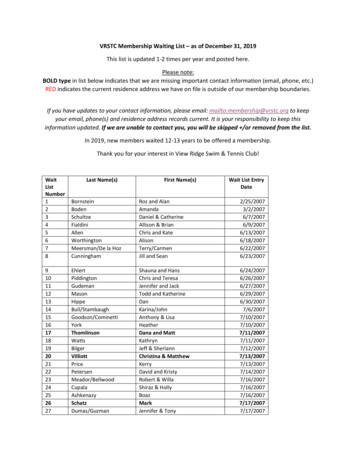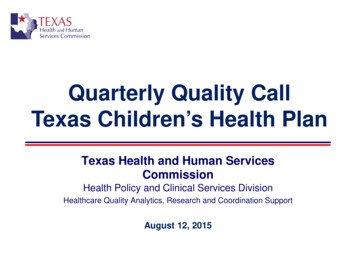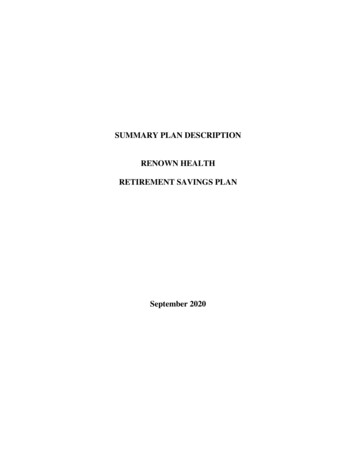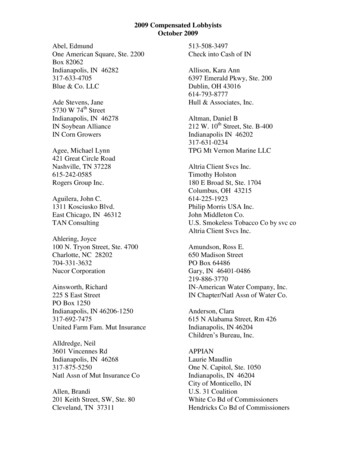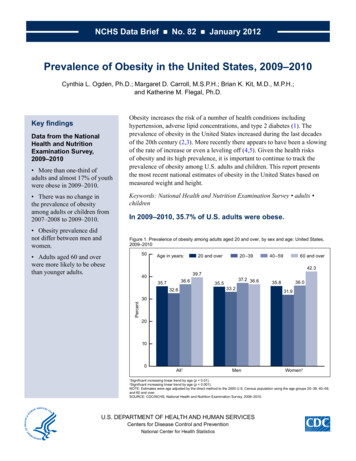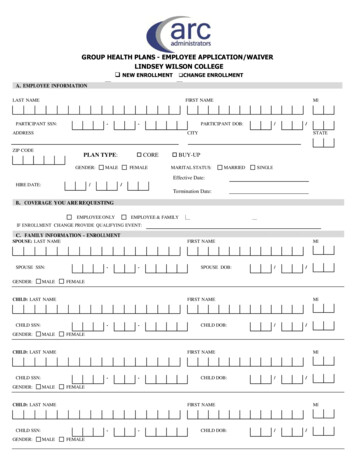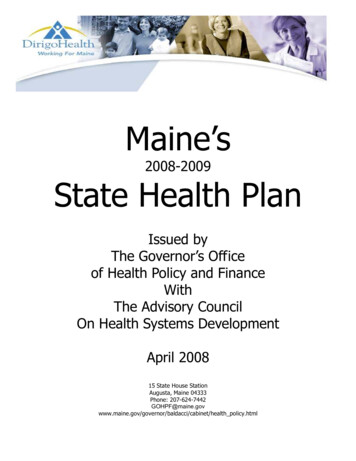
Transcription
Maine’s2008-2009State Health PlanIssued byThe Governor’s Officeof Health Policy and FinanceWithThe Advisory CouncilOn Health Systems DevelopmentApril 200815 State House StationAugusta, Maine 04333Phone: baldacci/cabinet/health policy.html
Maine’s 2008-2009 State Health PlanPage 2 of 124
Advisory Council on Health System DevelopmentMembersBrian Rines, PhD, ChairPyschologistGardinerRobert K. DownsHarvard Pilgrim Health CarePittsfieldLani Graham, MD, MPH, Co-ChairConsultantPortlandMeggan BeaulierSimply Divine BrowniesBrunswickMaroulla S. Gleaton, MDAtlee Gleaton Eye CareAugustaDora A. Mills, MD, MPHMaine Center for Disease ControlAugustaD. Joshua Cutler, MDMaine Quality Forum, Dirigo Health AgencyAugustaSenator Peter BowmanLegislatorKitteryAnne P. Graham, MSN, RN, CPNPMaine NeurologyNorth YarmouthSenator Lois Snowe-MelloLegislatorPolandAndrew F. Coburn, PhDMuskie School of Public ServicePortlandRepresentative Anne PerryLegislatorCalaisNona O. BoyinkMaine General Medical & HealthReach NetworkWatervilleRepresentative Charles PriestLegislatorBrunswickArthur J. Blank, CPAMount Desert HospitalBar HarborRepresentative Robert WalkerLegislatorLincolnvilleEdward F. MillerAmerican Lung Association of MaineAugustaJohn P. CarrMaine Council of Senior CitizensYorkDavid H. BrenermanUNUMPortlandMaine’s 2008-2009 State Health PlanPage 3 of 124
Maine’s 2008-2009 State Health PlanPage 4 of 124
Executive Summary 7Introduction . 13Chapter I – What is driving Maine’s health care costs? What We’ve Learned . 19How is Maine different from the U.S. and New England? . 22Variation in how care is delivered. 27Variation in cost of care (Inefficiency) . 29Cost versus price . 31Cost shifting . 31What’s the best way to make health care more affordable?. 32Chapter II – Responding to the Cost Drivers . 35I. Improving Health . 35A. Public Health Infrastructure – Build Local Capacity for Change by BringingHealth Information & Support to Maine Communities . 35B. Integrating Care – A Path to Better Outcomes while Lowering Costs. 381. Patient Centered Medical Home . 392. Coordination of Public Health and Behavioral Health Systems. . 423. Other Maine-based Integration Initiatives . 43C. Worksite Wellness. 44D. Supporting Dirigo’s Goal of Universal Access During Challenging EconomicTimes. 45E. Oral Health – Increase Focus on Prevention & Education, and Build Capacity ToDeliver Oral Health Services By Enhancing Partnerships & Collaborations . 48F. Rural Health - Building Access to Quality & Affordable Healthcare for RuralResidents . 49G. Telemedicine . 50H. Possible Role for Federally Qualified Health Centers (FQHCs) in ProvidingVeterans’ Care. 52II. Assuring Best Practices/Less Variation in Care Delivery . 54A. Emergency Department Over-Utilization . 54B. Reducing Variation in Medical Practice. 56C. Prototypes for Evidence Based Medicine - In A Heart Beat and Stroke Systems ofCare . 581. In A Heart Beat . . 582. Stroke Systems of Care . 59D. Finding the Right Place of Care for the Elderly and Disabled in Need ofAssistance. 59Maine’s 2008-2009 State Health PlanPage 5 of 124
III. Efficiency and Effectiveness. 62A. Medicare Equity Project. 621. Hospital Reimbursement. . 622. Medicare Hospice Benefit. 63B. Electronic Health Information – HealthInfoNet. 64C. Using Data to Enhance the Performance of Maine’s Public Health and HealthCare Systems . 661. Deepening the Analysis of Maine’s Healthcare Cost Drivers. 662. Using Maine’s Existing Research and Analytic Capacity to Greatest Effect. . 67D. Patient Safety. 691. Healthcare-Associated Infection . 692. Sentinel Event Reporting . 713. Critical Access Hospital Collaborative . 73E. Certificate of Need and the Capital Investment Fund. 74Chapter III. Accountability: Delivering on Our Promises . 82Appendix I - What We Accomplished . 90A. Public Health Infrastructure . 91B. Integrating Patient Centered Care – MaineCare's High Cost User CareManagement Benefit . 92C. Variation Analysis . 931. Charting Variation in Care . 932. A Prototype for Evidence-Based Medicine - In a Heartbeat Accomplishments. 93D. Creating Access to Affordable Health Care . 94E. Workplace Health – Helping Small Businesses Support Employee Wellness. 96F. Healthcare Workforce . 96G. Integration Initiatives . 97H. Rural Health . 98I. Telemedicine Workgroup . 98J. Health Status Report . 98Appendix II - Health Status & Demographics by Public Health District . 100Appendix III - Links to Recent Maine State Government Health Plans and Reports. 113Appendix IV - Statutory language pertaining to (1) the role of the State Health Plan as itrelates to CON, & (2) the Commissioner’s bases for CON decisions . 115Appendix V – Accounting for Age . 118Appendix VI – Glossary. 119Maine’s 2008-2009 State Health PlanPage 6 of 124
Executive SummaryThe State Health Plan is a roadmap to guide and reflect the action underway andthe next steps required to make Maine the healthiest state with an efficient andeffective, high-performing health system. Maine’s Dirigo Health reform lawrequires the Governor to develop and issue the plan with guidance from the 19member Advisory Council on Health Systems Development (ACHSD). ThatCouncil is appointed by the Governor, after review by the Legislature’s JointCommittee on Health and Human Services, to oversee the development anddissemination of the biennial State Health Plan.The State Health Plan recognizes the collaborative efforts of the many public andprivate groups involved in health system reform throughout the State:consumers, healthcare providers, public health officials, employers, payors,researchers and many others continually come together to tackle the difficultissues of healthcare reform. The ACHSD believes that it is the unique willingnessof Maine people to work together collaboratively that will enable Maine toachieve the goals established by the State Health Plan to become the healthieststate for all, with an efficient, effective and high-performing health deliverysystem.Yet, while these are important goals, they will not be easily achieved.Collaboration needs to be supported by consensus building and the leadership tomake tough decisions. They require all of us to change the way we think and actabout health and healthcare, to acknowledge that the health and healthcaresystems are complicated, intricately interwoven systems without quick fixes, andto be willing to move beyond individual self interest to what’s good for the wholehealth system.And Maine’s goals cannot be achieved by government alone. We encourage thecontinued and expanded involvement of all stakeholders both public and privateworking in partnership to achieve what no one interest group could achievealone.The strategies and actions outlined in the 2008-09 State Health Plan continue tomove us along the road for achieving Maine’s goals. And although we do notexpect to fully reach the goals of healthiest state with an efficient, effective andhigh-performing health delivery system by 2009, we do expect significantmeasurable progress – progress that the citizens of Maine need and deserve.The ACHSD expects that the tasks identified in this plan will be completed in thebiennium and will provide information on the impact of these actions onachieving Maine goals and needed next steps.Maine’s 2008-2009 State Health PlanPage 7 of 124
To acknowledge the difficulty of the road ahead and still move courageouslyforward, the ACHSD has set in motion a process whereby each biennium itidentifies meaningful actions towards the goals, learns from the results of thoseactions, and identifies new and/or continued actions that will enhance Maine’scapacity for achieving its goals. The executive summary is structured to reflectthis process: accomplishments to date, what we learned, and next steps.AccomplishmentsThe 2008-09 State Health Plan supports the work we need to do by defining andcoordinating actions that will build on the strong foundation that has been laidduring the past two years. The work at times has been grueling with manystakeholders involved, much information to be processed, and many ideas to beexplored. Yet, within this environment of complexity and frustration, great thingshave begun to happen. There is much to celebrate and many people to thank fortheir hard work and commitment. The following accomplishments represent justa few of the successes achieved: The Public Health Group completed the design of a consolidated and efficientpublic health infrastructure that will bring public health information andsupport to local and regional groups engaged in creating healthycommunities.The Maine Center for Disease Control (CDC/DHHS) supported the newinfrastructure by streamlining and consolidating 150 grants into 28 to createa more effective Healthy Maine Partnership System.MaineCare launched a pilot to improve the health status of its highest costusers by assuring they get the appropriate care and follow-up.The Maine Quality Forum’s (MQF) In-A-Heartbeat initiative is improving careof heart attacks statewide through a treatment map that uses evidence basedmedicine. Additionally, MQF trained people around the State in recognizingand responding appropriately and quickly to people experiencing heart attacksymptoms. Both the effects of the training and education as well as thequality of care for heart attack patients will be monitored through MaineCDC/DHHS.Dirigo Health has covered 28,300 people, and the Bureau of Insurance hasfound that Dirigo Health Reforms generated 111 million in savings over thefirst three years since Dirigo’s passage.As a result of Dirigo Health Reform’s rate regulation in the small employergroup market, insurers refunded 6.6 million to small businesses.The Governor’s Office on Health Policy and Finance (GOHPF) led a workgroup that developed a worksite wellness toolkit and provided trainings tosmall businesses enrolled in Dirigo.HealthInfoNet has made significant progress towards becoming one of thefirst statewide health information exchanges in the country by securing initialMaine’s 2008-2009 State Health PlanPage 8 of 124
financing and service contracts with the four large health systems and MaineCDC that will being the process of building efficiency and improved quality tothe healthcare delivery process through shared information.In both 2006 and 2007 Maine received “A”s across the board from theAmerican Lung Association in tobacco prevention, smoke free air, restrictingyouth access and excise tax.Maine was successful in reducing deaths due to cancer, coronary disease,stroke, and chronic lung disease.Average annual costs from hospital capital projects approved under theCertificate of Need program were 17% lower than the average in the eightyears prior to the Capital Investment Fund (CIF), resulting in projectedreduced costs of 22 million from 2006-2009.What We LearnedIn June 2007 the Maine Legislature increased the responsibility of the ACHSDwith a requirement to analyze healthcare cost drivers and makerecommendations that will lower the increase in the cost of healthcare in Maineto the increase in the cost of living. During the past year, the Council hasfocused much of its time on identifying specific elements of Maine’s healthcaresystem that are driving healthcare costs and in October 2007 issued a report,“ACHSD Data Book: Investigating Maine’s Health Care Cost /health policy.html). In keeping withLegislative intent, many of the recommended actions for this biennium are basedon this report, as well as on input received from the public during district healthforums around the state in Fall 2007 and from expert panels that advised theCouncil.The Council learned that, while the U.S. spends twice what peer nations do onhealthcare, we do not have better health or better quality, and Americans getthe right care only half of the time. Additionally, 47 million Americans lackaccess to healthcare coverage. Like other states, Maine’s healthcare costs aredriven primarily by utilization and inefficiency. However, Maine data shows thatwe spend more on healthcare and have lower health outcomes when comparedwith most national data. The following findings are of particular interest when weconsider the challenges to making Maine the healthiest state with an efficient,effective and high-performing health system: New England’s health care spending is higher than the national average, andMaine’s per capita healthcare spending is the second highest in the nation.Maine is above the national average in the available supply of healthcareservices:o Maine has 1.5 times the number of hospital-based MRIs as the U.S.average;Maine’s 2008-2009 State Health PlanPage 9 of 124
o Maine uses more out-patient & Emergency Room services than most otherNew England states;o Compared to other New England states Maine has among the highestnumber of staffed hospital beds per 1000 population and among thelowest occupancy rate; ando Maine has more physicians, nurses and rural clinics per 100,000population than the US average, although there are areas of significantshortages and an aging workforce that portends future problems.The cost for treating the same patient for the same illness in different Mainehospitals varies by as much as 20-60%.Nearly 37% or 1.2 billion of Maine’s increase in health spending from 1998to 2005 is attributable to the leading chronic illnesses, which are oftenpreventable: cardiovascular disease, cancer, chronic lung disease anddiabetes.Despite recent improvements, Maine has a higher average rate of deaths per100,000 in cancer, diabetes, and chronic lung disease than the US average.So while we have accomplished much in the first biennium, there remains asignificant gap between where we are as a state and where we want to be. The2008-09 State Health Plan focuses the next steps on specific cost driversidentified in the available data as a way of moving Maine more effectively towardits goals. The work ahead requires us to benchmark the results of these tasksagainst the goals we have identified and to continually report on the measurableprogress that we are making.Next Steps: Responding to the Cost DriversTo become the healthiest state with an efficient, effective high-performing healthdelivery system, we need to start with each of us – what we need to do asindividuals, families and communities to maximize our health. It will require willand better information, and it will also mean having a health system that worksfor all of us and with all of us, by: investing in prevention; providing the rightcare at the right time throughout the State; eliminating costly redundancy andvariation; assuring high quality; paying for the buildings, technology andequipment we need but not more than we need; and putting the patient at thecenter of the healthcare system.Further, the ACHSD understands that Maine’s health status depends on thehealth of the environment and looks forward to receiving reports from groupsworking to promote better air and water quality, reduce dependency onchemicals containing toxins (e.g. the Maine Medical Association’s Public AffairsCommittee working on toxins in the environment) and provide healthyneighborhoods and communities.Maine’s 2008-2009 State Health PlanPage 10 of 124
The council also recognizes the broad and complex nature of health systemsreform and believes the State Health Plan must focus its resources and attentionto those actions accomplishable within the biennium, so that the next steps wetake will bring substantive gains in developing the health and healthcare systemwe need in Maine.The 2008-09 State Health Plan’s next steps are organized in three majorcategories representing the change we want to see: (1) Improving Health,building a system that supports every person getting and staying healthy; (2)Assuring Best Practices/Less Variation in Care Delivery, making sure that everyhealthcare consumer receives the right care at the right time; and (3) Efficiencyand Effectiveness, eliminating redundant or ineffective systems and treatmentsso that every consumer gets the quality and services needed at the lowestpossible cost. Because these steps are based on the cost drivers indentified bythe ACHSD’s study, they will have a substantial impact on Maine’s movementtowards its goals.I. Improving Health Implement a streamlined and coordinated statewide public healthinfrastructure with a Local Health Officer in every municipality. Provide Healthy Maine Communities with information on the health status oftheir communities so they can design solutions targeted to their specificdemographics and needs. Identify ways to sustain and increase coverage for the uninsured andunderinsured population. Identify inhibitors and reforms needed to increase affordable products in thesmall group market. Continue MaineCare’s High Cost User Care Management Benefit. Implement a pilot in one district to improve coordination of public health andbehavioral health systems. Implement a public-private multi-payor pilot that pays for integrated patientcentered care (the Advanced Medical Home model). Create partnerships between higher education and healthcare providers toassure a supply of healthcare workers to rural areas. Develop recommendations for assuring all Maine people have access tocritical oral health services. Work to achieve an appropriately-developed, utilized and reimbursedtelemedicine infrastructure that serves the best interest of patients. Develop an evidenced based tool kit for employers to use in implementingworksite wellness programs.II. Assuring Best Practices/Less Variation in Care Delivery Convene a group of stakeholders to study the over-utilization of emergencydepartments for non-emergent care and to identify potential cost savings andMaine’s 2008-2009 State Health PlanPage 11 of 124
strategies for developing new models of 24/7 care for non-emergencyconditions.Decrease unwarranted variation in health care practice and utilization byintensifying the analysis and publication of data identifying the extent andnature of variation.Promote the utilization among Maine practitioners of practice standards thathave achieved national consensus.Continue to educate and promote the treatment protocol for heart attacksdefined in the “In a Heartbeat” initiative to reduce deaths by heart attack.Understand the needs of older adults, people with disabilities, and others whoface health disparities to assure the availability of quality, cost-efficient caredelivery systems.III. Efficiency and Effectiveness Increase the flow of Medicare dollars to Maine through advocacy for a wageindex adjustment. Increase utilization of the Medicare hospice benefit by eliminating barriers tohospice use. Support patient service integration, quality improvement, and enhancedpatient safety by supporting and advocating for utilization of interoperableelectronic health information systems and a statewide health informationexchange system. Refine and improve the State Health Plan’s Certificate of Need (CON) criteriato: encourage efficient and coordinated use of healthcare and health servicesin the CON applicant’s area; and guide DHHS in prioritizing CON approvedprojects within the Capital Investment Fund (CIF) limit. Evaluate the CIF to assure that the process and amount supports costeffective long term planning Complete a report that analyzes State claims data and identifies andquantifies specific cost drivers, to inform actions at the State, District andlocal levels. Identify strategies for improving, increasing, and coordinating Maine’s healthdata analysis capacity to enable deeper cost and utilization analysis, and toimproving abilities to address health disparities. Collaborate with Maine hospitals to monitor and publish Healthcare-AcquiredInfections and promote infection prevention standards and practices.It is unrealistic to hope these steps will result in Maine’s fully achieving its goalsin the next biennium. Meaningful and sustainable change takes time, energy,thoughtfulness, and commitment. What has been accomplished is worthcelebrating. What will be accomplished is worth working for. Hope grounded inaccomplishment will continue to fuel the work that lies ahead.Maine’s 2008-2009 State Health PlanPage 12 of 124
IntroductionDirigo Health Reform, enacted in 2003, provides a comprehensive approach toreduce costs, improve health, increase access to health coverage, and improvethe quality of care we receive. It established as a priority the creation of abiannual plan (the State Health Plan) to improve the health of our state, and tomake quality health coverage more affordable and accessible to all Mainecitizens. The Dirigo reform set out a three part strategy – the most significantand least understood being a commitment to a more efficient, effective healthsystem which will help make universal coverage possible in large measure byaddressing affordability. Dirigo intends to make coverage more affordable byimproving health and the quality of care of all Maine people; healthier peoplerequire less costly healthcare services.Each biennium, the State Health Plan identifies initiatives that define how Mainewill fulfill the intent of the Dirigo Health Reform.The health of the people of Maine is inextricably integrated with the State’seconomic success, its environment and its quality of life. The 2006-07 StateHealth Plan set as its goal “to make Maine the healthiest state.” Being thehealthiest state requires everyone in Maine to have access to quality, affordablehealthcare, information about health and health care, and a clean and healthyenvironment. The health of the population requires systems that work efficientlyand effectively, systems that effectively address health disparities, and systemsthat support health and remediate illness and disease while providing thefinancing that properly incentivizes disease prevention and health maintenance.In 2007 the Maine Legislature expanded the role of the Advisory Council onHealth Systems Development (ACHSD) to conduct a cost driver study to helptarget the primary contributors to the increased cost of healthcare. As a result,the 2008-09 State Health Plan includes the goal “to have a cost-effective,efficient and high-performing health system.” While many issues influenceMaine’s ability to achieve healthiest state status – environmental quality,economic opportunity, education, for example – the ACSHD in keeping with itslegislative mandate has focused on the issues identified in the cost driver study.The ACHSD believes that the two goals – healthiest state and cost-efficient,effective, and high-performing health system – can be achieved by supportinginitiatives that promote health, enhance appropriate utilization of healthcare, andreduce system inefficiencies. The State Health Plan supports these goals by: Providing a comprehensive look at the many efforts in progress around theState to improve Maine’s health and healthcare delivery system.Assuring health and healthcare initiatives that are value added and notduplicative.Enhancing shared information and analysis.
Identifying the key barriers to improved health and healthcare delivery.Maximizing resources.Holding those responsible for improving Maine’s health status accountable forresults.Informing the Governor, Legislature, and the public of the status of Maine’shealth system and any actions needed to move Maine toward the goal ofhealthiest state.Assuring that there is public input into the State Health Plan.Focusing on elimination of health disparities.The goals are lofty, and the challenge is great. As indicated in the chart belowMaine has socio-economic factors that present difficult, though notinsurmountable challenges.Socioeconomic and Demographic Factors: Maine vs USpeople persquare mileMaineU.S.41.3 (2006)79.6 (2000)MedianHouseholdIncome(2004) 41,287 44,334% HSEducation(2000)% familiesIn poverty(2004)14.69.411.311.5% AdultsWith aDisability(2006)23.815.1Age 65(2006)14.612.4*See appendix II for demographic and health status information by Maine publichealth districtsHowever, it is because of Maine’s socio-economic challenges that it is especiallyimportant that healthcare be made more affordable. Maine must reduce thefinancial burden of healthcare costs on consumers, tax payers, and employers.The Cost Driver study released in October 2007 reports on the extent thatMaine’s per capita healthcare costs exceed those of the US and other NewEngland states. Maine is therefore particularly challenged to meet the healthcareneeds of its population while not burdening it with an unaffordable healthcarebill. Access to healthcare is primarily a factor of costs. If costs preventconsumers from getting the health and healthcare services they need, Maine’sgoal of healthiest state will remain unachievable.As ACHSD, supported by the Governor’s Office on Health Policy and Finance(GOHPF), has gathered and analyzed data over the past two years, it hasbecome clear that Maine has efficiencies to be gained in its healthcare deliverysystem that will enhance quality and access by shifting from disease treatment todisease prevention and health maintenance. These goals will be pursued with thefull participation of the public and the many groups currently involved inimproving our health and healthcare delivery systems. Health is ultimately lesscostly than disease. Being the healthiest state is our goal; doing it within ourresources is our challenge. We will ask all stakeholders private and public tocontinue their hard work and to remain thoughtful, innovative and willing to stepbeyond their particular interests to assum
Maine's 2008-2009 State Health Plan Page 7 of 124 Executive Summary The State Health Plan is a roadmap to guide and reflect the action underway and the next steps required to make Maine the healthiest state with an efficient and effective, high-performing health system. Maine's Dirigo Health reform law
